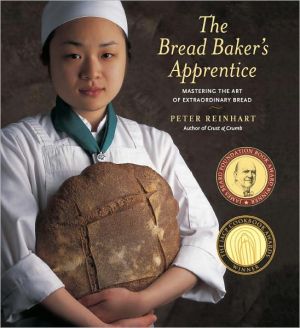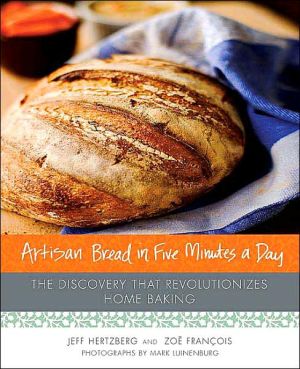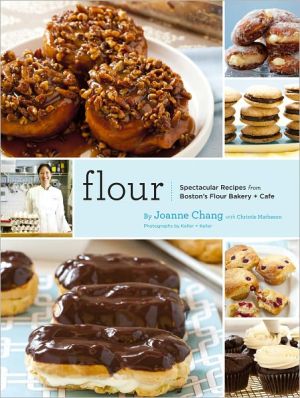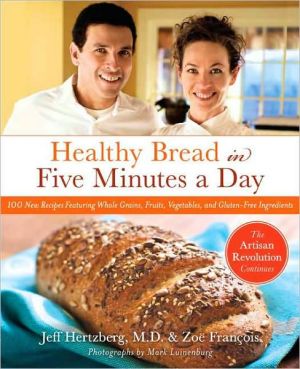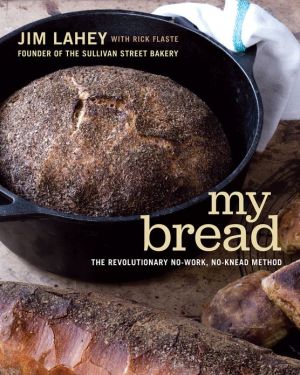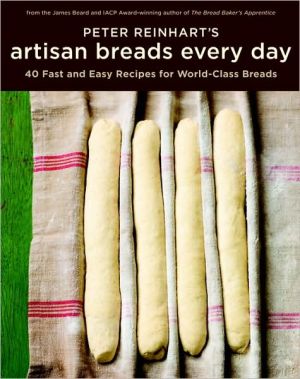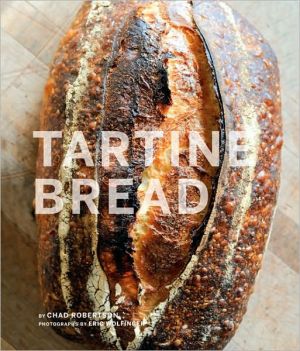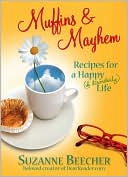Bread Baker's Apprentice: Mastering the Art of Extraordinary Bread
Co-founder of the legendary Brother Juniper’s Bakery, author of the landmark books Brother Juniper’s Bread Book and Crust & Crumb, and distinguished instructor at the world’s largest culinary academy, Peter Reinhart has been a leader in America’s artisanal bread movement for over fifteen years. Never one to be content with yesterday’s baking triumph, however, Peter continues to refine his recipes and techniques in his never-ending quest for extraordinary bread.\ In The Bread Baker’s...
Search in google:
Co-founder of the legendary Brother Juniper’s Bakery, author of the landmark books Brother Juniper’s Bread Book and Crust & Crumb, and distinguished instructor at the world’s largest culinary academy, Peter Reinhart has been a leader in America’s artisanal bread movement for over fifteen years. Never one to be content with yesterday’s baking triumph, however, Peter continues to refine his recipes and techniques in his never-ending quest for extraordinary bread.In The Bread Baker’s Apprentice, Peter shares his latest bread breakthroughs, arising from his study in several of France’s famed boulangeries and the always-enlightening time spent in the culinary academy kitchen with his students. Peer over Peter’s shoulder as he learns from Paris’s most esteemed bakers, like Lionel Poilâne and Phillippe Gosselin, whose pain à l’ancienne has revolutionized the art of baguette making. Then stand alongside his students in the kitchen as Peter teaches the classic twelve stages of building bread, his clear instructions accompanied by over 100 step-by-step photographs.You’ll put newfound knowledge into practice with 50 new master formulas for such classic breads as rustic ciabatta, hearty pain de campagne, old-school New York bagels, and the book’s Holy Grail–Peter’s version of the famed pain à l’ancienne. En route, Peter distills hard science, advanced techniques, and food history into a remarkably accessible and engaging resource that is as rich and multitextured as the loaves you’ll turn out. This is original food writing at its most captivating, teaching at its most inspired and inspiring–and the rewards are some of the best breads under the sun.Praise for The Bread Baker’s Apprentice . . .Peter has combined the knowledge, passion, and expertise of a professional baker with the clear persuasive language of a born teacher. I predict immense well-deserved success for this extraordinary book.–Carol Field, author of The Italian BakerAs we continue our bread-making journey into the 21st century, Peter Reinhart’s The Bread Baker’s Apprentice should emerge as the definitive text on the subject. There is simply no other work where a student, and for that matter, many seasoned bakers, can turn to understand how the magic of great bread baking works. –Charles Van Over, author of The Best Bread EverPeter has yet again woven a fine tale about great bread, and his passion abounds. In The Bread Baker’s Apprentice, he delivers a tool box of information and insight–tools that empower us to roll up our sleeves and keep those ovens full! –Peter Franklin, Chairman of the Board, The Bread Bakers Guild of AmericaThis remarkable book is written and designed to bridge the information gap between professional artisan baking and simpler home baking. The tricks, the tips, the checklists, the math, the lingo, the path to perfect fermentation, are all here at my fingertips. –Beth Hensperger, author of Bread Made EasyIf you are a serious home baker and wish to raise your level of baking several notches, then apprentice yourself to master bread baker Peter Reinhart in his new cookbook, The Bread Baker’s Apprentice. He instructs with gusto in this delightful and comprehensive volume. –Bernard Clayton, author of The Breads of FranceJust as bread nourishes the body, The Bread Baker’s Apprentice nourishes the baker’s soul. Peter Reinhart’s explicit recipes and detailed instructions are so well written that he takes the mystery out of mastery, giving you the sense that he is standing right beside you, coaching you to success.–Flo Braker, author of The Simple Art of Perfect BakingBoth novice and experienced bakers have cause to celebrate Peter Reinhart’s The Bread Baker’s Apprentice. Peter’s years of hands-on experience combined with his excellent teaching skills make this book the closest thing to having a master at your side as you bake.–Lora Brody, author of Basic BakingAUTHOR BIOPETER REINHART is a full-time baking instructor at Johnson & Wales University in Providence, Rhode Island. He is the author of the acclaimed Brother Juniper’s Bread Book: Slow Rise as Method and Metaphor, Sacramental Magic in a Small-Town Café, Bread Upon the Waters, and Crust & Crumb, the winner of the James Beard/KitchenAid Cookbook Award in 1998. Peter is a regular commentator on food and culture for public radio’s One Union Station. Library Journal Author of the well-respected Brother Juniper's Bread Book and Crust & Crumb, baker-turned-culinary instructor Reinhart draws on his baking and teaching experience to provide an authoritative but unintimidating guide to baking professional-quality loaves of all sorts. He begins with an account of a recent tour of specialty bakeries in Paris, including Gosselin, where he learned to make the young baker's unique pain l'ancienne which, Reinhart says, would be better called pain moderne, as it uses a modern invention (the refrigerator) to produce a "cold-dough delayed-fermentation" baguette, the best he has ever tasted. He found this technique revolutionary, and he includes the recipe here, along with a wide variety of other artisan and classic breads, from Ciabatta to Poilene-Style Miche to Tuscan Bread. The recipes are preceded by a 50-page primer on the "twelve stages of bread," and there are dozens of photographs, including particularly helpful ones of shaping different loaves. Valuable for both the professional and the novice, this is highly recommended for all baking collections. Copyright 2001 Cahners Business Information.
\ \ \ \ Chapter One\ \ \ What Is It About Bread?\ \ \ On August 7, 1999, on a drizzly, chilly day typical to the region, thousands of pilgrims flooded a four-block area of southwest Portland, Oregon, in a park near Portland State University. They didn't come for religious reasons but to venerate with religious zeal their newly emerged passion for the world's most symbolically evocative foodstuff: bread. Not just bread, but good-as-it-gets bread, made by artisans of the Pacific Northwest using techniques discovered either accidentally or from the dissemination of arcane knowledge brought to this country only recently by European bakers through the Bread Bakers Guild of America, itself a throwback to days of yore. The Summer Loaf Festival, as it is called, is one of the first of what may soon be a nationwide parade of tributes to the hottest food trend since, well, sliced bread. (Note: The Summer Loaf Festival is not the actual first bread festival, which occurred two years earlier in Sonoma County, California, and was called, cleverly, the Grainaissance Fair.)\ The French call it simply pain ordinaire, "ordinary bread." What the new, young American bakers have discovered, and what they proudly displayed in dozens of booths at Summer Loaf, is that there are many layers of flavor hidden within the four ingredients of flour, water, salt, and yeast that are the sole components of true French bread. They have taken up the timeless baker's challenge of evoking from the wheat its fullest potential, finding ways of unraveling the tasteless starchmolecules that comprise the bulk of a loaf by attempting to spring free the simple sugars that are woven within the complex but unassailable carbohydrates. When they successfully accomplish this, using bakers' tricks that are both ancient and modern, layers of flavor emerge as if from one of those magic-eye, three-dimensional, there-it-is, wait-where-did-it-go paintings. Flavors slowly come into focus as the palate, with its five flavor zones, aided by the chewing process and the release of salivic enzymes, encounters it first in the sweet zone, eliciting an "ahhh, this is nice," reaction. Then the salty zone kicks in, an "oohhh," followed by another level of either sweetness or sourness (depending on the bread), along the sides of the tongue, calling forth a "hmnnn, whoaa...." Finally, just at the swallowing point, the mouth floods in the umami, or rich zone in the back central region, with a nutlike flavor that perfumes its way into the sinuses, where it lingers for as long as fifteen to thirty minutes, re-creating with every inhalation the inimitable finish of a proper, world-class bread—the inevitable "yessss!" (accompanied by appropriate arm pumping, in rare instances). This flavor joy is in addition to the various auditory pleasures of the sound of crust, crackling and crumbling under the pressure of the chew, and the visual satisfaction caused by both the rich, dusty, reddish gold caramelization of crust and the blooming of the loaf along the slash marks. The blooming produces what the French call the grigne, an ear of crisp crust that neatly separates from the loaf like a proudly curled lip. Bread this good must also be beautiful; after all, in our culinary schools it is taught that we eat first with our eyes.\ I teach bread baking in a large culinary school. My students are mostly young wannabe and soon-to-be pastry chefs and bakers, and I have less than five weeks to teach them everything, or nearly everything I know about bread. What I'd like to do is first send them to Summer Loaf and Grainaissance festivals, or to Paris with its two hundred and fifty bread shops, so they can be swept into the romance of the bread revolution as I have been. Instead, what I am required to do is teach them formulas and how to safely work the ovens and use stationary and spiral mixers, powerful tools that will rip off their hands if they get too anxious and prematurely feel their dough. Since feeling the dough is really where the magic begins, I rapidly make my way through the boring but necessary safety requirements to get to the stuff of which baker's dreams are made. Usually somewhere around the third or fourth week, it—the magic—happens for most of my students.\ In Zen and the Art of Motorcycle Maintenance, a book that came out, coincidentally, around the same time as the Tassajara Bakery began selling bread made by American Zen Buddhist students in San Francisco, Robert Pirsig wrote of two kinds of motorcycle riders. Some like to tinker with their bikes, making sure they are tooled just right, and the others just like to ride and feel the wind against their cheeks. Bread bakers are like that, too. The more technical and mechanical bakers often go to Manhattan, Kansas, where there is a superb school called the American Institute of Baking. There they learn all about the properties of wheat and the effect of multitudinous sugars upon various strains of yeast. They learn dough formulas, and they learn about equipment options and methodologies. Graduates of this program become valuable technical bakers, usually for large companies, and earn good salaries, troubleshooting problems and guaranteeing consistency in operations that may produce forty thousand or more loaves a day.\ The other type of baker, the wind-on-cheek baker, often opens a small bakeshop and makes what has become known as artisan bread, the term artisan having been driven, sadly, to near meaninglessness by its recent ubiquity. These are the bakers who tend to rhapsodize about their loaves. ("They are loaves, please don't call them products.") Many of them travel to Europe, making pilgrimages to the house of Poilâne or Ganachaud, and gather at bread bakers' guildhall meetings, held whimsically throughout the year, to discuss the merits of various baguette-shaping techniques or the hydration potential of their latest experimental ciabatta. They philosophize, read and write books, and argue about the ever-shifting line between the true artisan and the mass producer or the merits of supporting small-scale wheat farmers who grow heirloom strains. These bakers get very excited every time they learn a new technique or hear that the French professor Raymond Calvel might be coming to town. (That's not very likely these days, as the bread teacher of bread teachers is in his late eighties and has already committed his knowledge to a superb series of videos he made with the Bread Bakers Guild of America in 1994.) When they go to France, Germany, or anywhere where good bread might be found, they come back with new ideas and add ever more dialogue to the still-building buzz.\ My students, being younger than these entrepreneurial bakers who have now changed the American bread paradigm, may become either technical or romantic bakers, or a hybrid of the two, or they may never get grabbed by the bread-geist. Many of them initially view my class as a necessary prerequisite to get them to the plated-dessert or wedding-cake class, but then find themselves inexplicably falling under the spell of pain au levain, ciabatta al funghi, or pain à l'ancienne. Some fight against the discipline of repetitive drills, shaping baguette after baguette—not a simple matter—and trying in vain to match their slashes, or scoring cuts, in a consistent pattern. I never know on the first day who of my twenty or so students will emerge on the twenty-second day as bread revolutionaries, but I know some of them will. It usually happens before they taste the pain a l'ancienne, but if it hasn't happened by then, that is the bread that seduces them. If it still doesn't happen, I pray, having taken my best shot, that they will discover their culinary awakening in the chocolate or cake class.\ Many of my former students have long since graduated and are working in the field, sending e-mails or dropping in from time to time to share their "war" stories. A number of them tell me it was the pain à l'ancienne that first grabbed hold of their imagination, and now that they are out and exposed to even more varieties, they can't seem to get bread out of their systems, even if they have become pastry chefs rather than bakers.\ I learned about pain à l'ancienne in Paris in 1996, when I went over to collect on my prize for winning the James Beard National Bread Competition in 1995. I won with a simple sourdough, a country boule (ball), made with an unusually high proportion of sourdough starter. I baked my winning loaves at Amy's Breads on the west side of Manhattan, rushing them straight from Amy's many-thousand-dollar Bongard steam-injected oven into the trunk of my friend Joel's car. He's a locksmith and thus knows the fastest ways through town, and he safely delivered me and the bread to the James Beard House in Greenwich Village.\ The Beard House is one of the meccas of the American food scene. When James Beard, the rotund food writer and America's most famous gourmand, died in 1982, a group of his friends and colleagues started a foundation in his memory to perpetuate interest in the burgeoning American culinary explosion. They eventually paid off the mortgage on his house and turned it into a sort of museum and dining showcase for upcoming and seminal chefs, regularly hosting theme meals prepared by various culinary artists brought to town for the occasion. They also bestow prestigious cookbook awards and honor the top American chefs every year at their gala, an Oscar-like ceremony aptly called the James Beard Awards.\ The bread competition was organized for the Beard Foundation by author and teacher Nick Malgieri, the head baking instructor at the Peter Kump's New York Cooking School and a onetime acquaintance of the late James Beard. Prior to the finals, Nick traveled around the United States staging regional competitions, inviting the eight regional winners to New York for the final bake-off in January 1995.\ I had won the California regional in October by unexpectedly defeating Craig Ponsford, who a few months later would win the world championship of breads at the Coupe du Monde de la Boulangerie competition in Paris, the so-called Bread Olympics. I believe the California regional Beard competition was the only time Craig ever lost a head-to-head competition. When I, in false modesty, whispered to him after my name was announced, "I can't believe it," he understandably responded, "Me neither." His loaves were a multigrain sourdough, perfectly formed, loaded with complex flavors, made at Artisan Bakers, his bakery in Sonoma. My two large sourdough boules, made from a starter I'd been cultivating for about three months, were baked at home on a pizza stone and spritzed with water from a plant mister. It was an experimental dough, using a ratio of about 80 percent starter to flour, very unusual as most sourdoughs use only about 25 to 35 percent starter to flour. The loaves came out of the oven somewhat misshapen, having spread sideways and upward. The cuts were okay but not particularly attractive, blooming to form only a slight grigne but without creating any ears. The crust had a wonderful golden glow and was blistered from the long overnight proofing in my refrigerator. By true French standards this would not have been a winning bread, but on that particular day, with those particular judges, the rustic quality and the bold sour flavors gave it a small edge over Craig's perfect, but less rustic, loaves. I happily collected my regional prize, which was a free trip to New York City to compete in the finals, knowing I would have to do better to stand any chance of winning the real prize: a week in Paris to study with the boulanger of my choice.\ There is a huge difference between baking bread in a real bread oven and a home oven, but even the best oven cannot produce great bread if the dough itself is not fermented properly. Fermentation is the key to world-class bread, assuming that the flour and other ingredients are good. I was able to win the regional event because I had great dough going into the less-than-great electric oven in my home. Compensating for a lack of real steam with plant misters and other oven tricks to simulate the blast of steam a good Bongard, Tibbouletti, or Werner-Pfleiderer hearth oven produces was an audacious, but successful, attempt to prove a point. In my opinion, the quality of the dough is responsible for at least 80 percent of the finished product, while the oven is worth only about 20 percent. When I got to Amy's Breads, I was able to create an even better dough than my regional batch, having had three months of practice to refine my formula and mixing times.\ Amy Scherber and Toy Dupree, the owners of Amy's Breads, were kind enough to let me work around their production schedule during the competition. Amy is one of the leading personalities in the American bread revolution, a founding board member of the Bread Bakers Guild of America, and a smart businesswoman. One of the signature items at Amy's Breads is a semolina twist that simply flies off the shelf. Her bread confirmed my own growing interest in semolina breads, or pane siciliano, which is a good example of how the bread revolution spreads.\ Making bread in someone else's bakery is a challenge, and I had to estimate fermentation times based on ambient temperature because Amy's did not, at that time, have a temperature-controlled proof box. One of the keys to my formula is leaving the shaped loaves in the refrigerator overnight for their final slow-rise fermentation (we call it retarding the dough). This allows the bacterial fermentation to catch up to the wild-yeast fermentation (two types of fermentation plus a whole lot of enzyme action are at the heart of sourdough bread) and allows the starches to unwind into sugars as the dough slowly rises to its appropriate prebake size. When I arrived the following morning to bake off the loaves, I discovered I had miscalculated the temperature of the walk-in refrigerator, and my loaves were far from ready to go into the oven. I had to find a way to warm them, to wake them up, so that they could complete their rise. Without a proof box on a cold, snowy New York morning, I was at the mercy of ingenuity. Amy told me the warmest place in the bakery was at the top of the stairs leading to the basement. "That's where I put my doughs when they're too small," she advised. "But watch out for the stairs—don't let the racks roll down," was her final warning. I rolled my two racks of shaped bread dough, each loaf nestled in a canvas-lined bentwood willow basket (or banneton, as it is called in France) to the top of the stairs where a warm breeze drifted from the basement. It was 8 A.M. and I needed to have finished bread ready to transport by noon, when Joel would arrive to wend us through the icy streets to the Village. There was nothing I could do but wait and hope the dough would wake up and respond to the warmth with some movement. I parked the rolling racks at the top of the stairs, warning everyone on the production team not to jostle them lest they tumble into the abyss. I then went across Ninth Avenue to get a bagel and read the Sunday Times, a pleasure I had been denied during the twenty-five years I lived in California.\ Two hours later I returned to the bakery, relieved to find the racks still at the top of the stairs, but the dough was still undersized. I decided that 11 A.M. was my drop-dead time. I killed the hour by hanging out with the bakers, shaping loaves with them, talking bread philosophy—the usual baker stuff—and then took my loaves, still looking too small, to the oven, hoping they'd give me a good oven spring when the steam engulfed them. I had made two sizes: a nineteen-ounce bâtard, or torpedo-shaped loaf, and some three-pound miches, or large boules. I lined them up on the conveyor loader, scored them with either crosshatch pound signs, angled slashes, or asterisk stars, and pushed the conveyor into the eight-foot-deep oven deck. This action engaged the flanges of the loader into special brake slots, and then I pulled the conveyor out of the oven as it neatly dropped the loaves, one by one, onto the stone deck. After the deck was loaded, I pushed the steam button, causing a large blast of steam to billow out into the oven for twenty seconds. The steam moistened the skins of the dough to prevent them from gelatinizing too quickly, allowing the loaves to spring to their full size as the yeast completed its final feeding frenzy, at least until the center of the loaves reached 140°F, killing the last of that most useful of fungi. The oven kick, as it's called, usually produces a size increase of 10 to 15 percent. But on this particular day, in that particular oven, with my particular dough, the loaves kicked a whopping 20 percent, bloomed open perfectly, producing grignes distinct enough to allow me to carry each loaf by its ear. The caramelization of the crust, the distinct Maillard reaction unique to bread and just a few other products (see page 95), was a rich golden brown with tones of red, so soothing to the eye, so appealing and appetizing that it could, and did, induce tears.\ As if on cue, Joel pulled up to the shop, moved his locksmithing tools around in the trunk to make room, and helped me load the bread, about thirty loaves, into empty flour sacks. Then it was hugs to the bakers, good luck, good luck, good luck, thank you, thank you, thank you, and we were off to the Beard House. Once there, we chose the two most perfect specimens for the judges, placed the others under the table, went around the corner to a café for cappuccino and hot chocolate, and caught up on old times knowing there was nothing more we could do but wait for the judging. Joel had just sold a book of locksmith stories to a publisher, and I had just sold a bread-book concept to a different publisher, so we talked writer talk instead of bread talk. It's very similar.\ An hour later we went back for the announcements. The competitor whose bread impressed me the most was Biagio Settepani of the Bruno Bakery in Brooklyn. His loaves were not as visually stunning as mine, but the flavor was spectacular, with a sweet, creamy crumb that was as satisfying as a bowl of Cream of Wheat on a cold winter morning. He and his young son worked at the opposite side of the table from me as we, and the other finalists, cut small slices of our loaves for the hundreds of guests and spectators to taste. The other competitors had flown in from Texas, Oregon, Washington, St. Louis, and Boston. All the breads were wonderful. One was a four-pound rye bread with a cocoa-stenciled floral design baked onto the crust. Another looked just like my loaves, but the inside, the crumb, was tighter and a little dry. Mine were probably the best I'd ever baked: the inside and outside, the crumb and the crust, perfectly matched, the flavor and texture of the crumb, its mouth feel, cool and creamy even while still warm from the oven (with bread, the antithesis of cool is not warm but dry). The sour was properly complex, changing flavors in the mouth with each chew. What I call the "loyalty factor" kicks in just after swallowing, as the lactic and acetic acids produced by the bacterial fermentation work their way into the sinuses for the "thirty-minute finish." When the judges announced that I had won, I was relieved but not shocked. If not then, then never. I called my wife, Susan, in Santa Rosa, and when she answered the phone, I sang the first few words of "La Marseillaise." She squealed with delight. We were going to France.\ \ \ It took a year and a half to arrange the logistics for the trip. The prize money made available from Godiva Chocolate through the James Beard Foundation was supposed to be used to underwrite a one-week stage, or training session, with a baker of my choice in Paris. Stephanie Curtis, an American living in Paris, was the liaison and I was told to contact her to work out the details. I asked her if it would be possible to meet with five bakers for one day each, rather than one baker for five days. I didn't really want to spend my time in Paris making bread while Susan went out alone to sightsee and shop. What I really wanted was a crash tour of the best bread bakers and enough time to interview them and pick their brains. I figured two hours per baker. My interest was as a writer and teacher more than as a commercial baker, and I was looking for a thread, something to bring back to my student that I didn't know and that they might not hear about any other way.\ (Continues...)\ \ \ Excerpted from The Bread Baker's Apprentice by Peter Reinhart. Copyright © 2001 by Peter Reinhart. Excerpted by permission. All rights reserved. No part of this excerpt may be reproduced or reprinted without permission in writing from the publisher. \ \ \ \
AcknowledgmentsixIntroduction1I.What Is It about Bread?7II.Deconstructing Bread: A Tutorial27Assumptions and Rationales27The Twelve Stages of Bread: Evoking the Fullness of Flavor from the Grain48III.Formulas103The Final Grace Note: Wood-Fired Baking in Bennett Valley273Resources285Index293
\ From Barnes & NobleThe Barnes & Noble Review\ Bread-heads, rejoice! Now you can dramatically improve your bread-baking skills by apprenticing yourself to Peter Reinhart, a leader in America's artisanal bread movement for the past few decades. \ At Johnson & Wales University, the world's largest culinary school, Reinhart presides over a 22-day bread lab that teaches students the classic stages of bread baking, from mise en place fermentation, degassing, shaping, and panning to storing and eating. His cumulative knowledge, visits to the Parisian bread shrines of Poilâne and Gosselin, and recent set of technical breakthroughs are all in this book. Step-by-step color photographs clearly illustrate the techniques.\ This is a book that succeeds on many different levels -- as a beautiful art-style cookbook, a well-illustrated teaching manual, and a gracefully written reflection on the art of bread making. Reinhart's passion for making artisanal bread is contagious.\ "My goal is not to make you into a dogmatically doctrinaire baker, what I call a letter-of-the-law baker," writes Reinhart. "Instead, I want to help you become a spirit-of-the-law baker...one who has a sense of what the options are and thus is free to choose the options that will bring about the desired outcomes."\ Reinhart provides 50 new master formulas for rustic ciabatta, New York bagels, cinnamon rolls, sticky buns, classic rye, miches, boules, and his award-winning version of the famous pain à l'ancienne. The chapter on sourdough breads alone is probably worth the price of admission for any serious home baker.\ A final chapter on resources leads you to many excellent bread books, baking and culinary web sites, schools and training programs, and grain suppliers across the country. (Ginger Curwen)\ \ \ \ \ \ Library JournalAuthor of the well-respected Brother Juniper's Bread Book and Crust & Crumb, baker-turned-culinary instructor Reinhart draws on his baking and teaching experience to provide an authoritative but unintimidating guide to baking professional-quality loaves of all sorts. He begins with an account of a recent tour of specialty bakeries in Paris, including Gosselin, where he learned to make the young baker's unique pain l'ancienne which, Reinhart says, would be better called pain moderne, as it uses a modern invention (the refrigerator) to produce a "cold-dough delayed-fermentation" baguette, the best he has ever tasted. He found this technique revolutionary, and he includes the recipe here, along with a wide variety of other artisan and classic breads, from Ciabatta to Poilene-Style Miche to Tuscan Bread. The recipes are preceded by a 50-page primer on the "twelve stages of bread," and there are dozens of photographs, including particularly helpful ones of shaping different loaves. Valuable for both the professional and the novice, this is highly recommended for all baking collections. Copyright 2001 Cahners Business Information.\ \
